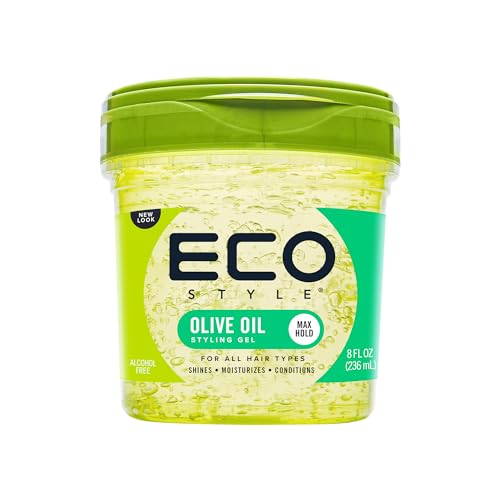
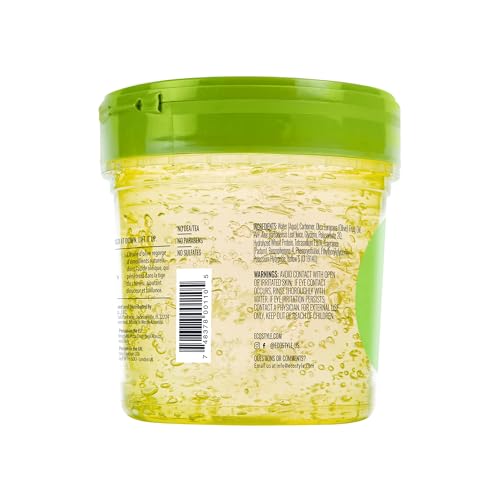
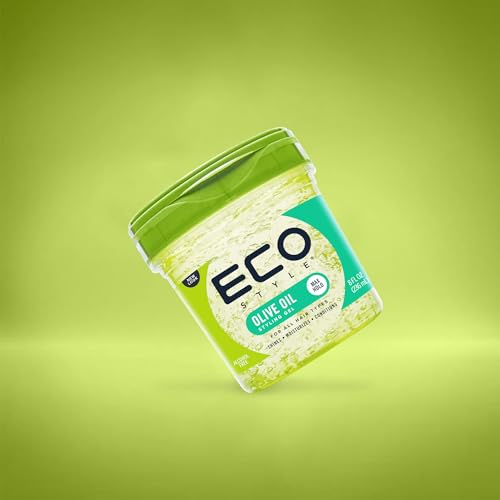
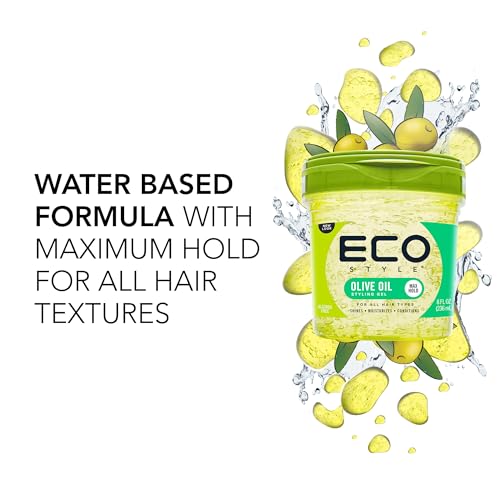
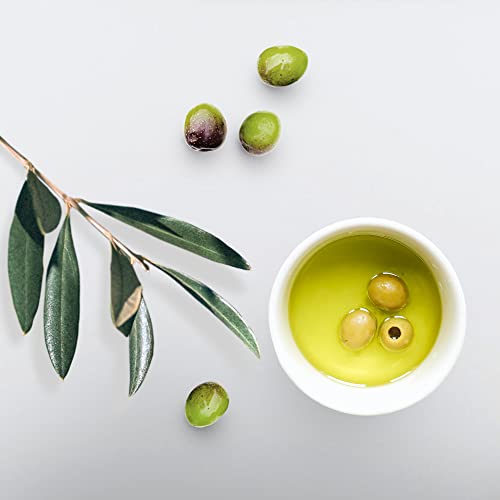
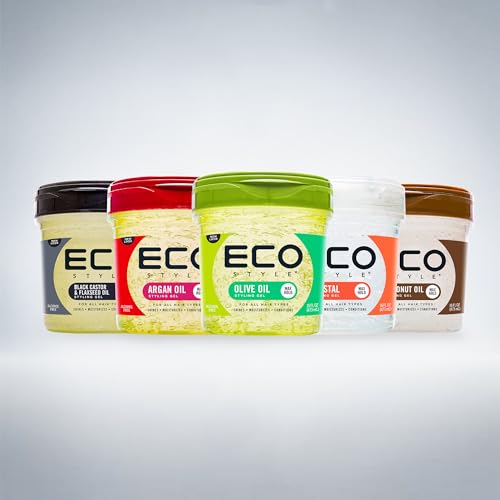

Eco Style Olive Oil Hair Gel - Moisturizes, Adds Shine, Tames Split Ends - 8 oz


Potassium Hydroxide
High RiskPotassium hydroxide is a caustic inorganic base commonly used in various products for its ability to adjust pH levels and act as a cleaning agent. It is highly soluble in water and can produce heat upon dissolution, making it effective in certain formulations.
Sustai Insights
Potassium hydroxide serves as a strong pH adjuster and cleaning agent, but it poses significant health risks due to its caustic nature, which can cause irritation to skin and eyes. Environmental concerns include its potential to contribute to water pollution. Regulatory bodies have imposed strict usage restrictions due to these hazards, leading to a high-risk overall assessment. Safe handling practices are essential, and alternatives such as citric acid may provide safer pH adjustment without the associated risks.
Hydrolyzed Wheat Protein
High RiskHydrolyzed wheat protein is produced by acid or enzymatic hydrolysis of wheat gluten, resulting in smaller protein fragments that can be easily absorbed by hair and skin. This ingredient is commonly used in personal care products for its moisturizing and film-forming properties.
Sustai Insights
Hydrolyzed wheat protein offers functional benefits, such as enhancing moisture retention and improving product texture. It is generally considered low risk for carcinogenicity, with moderate potential for allergies. Regulatory restrictions apply, particularly for products that must avoid specific allergens. Environmental concerns include its potential as a pollutant; however, it is not known for bioaccumulation. Safe usage practices are recommended for sensitive individuals, and alternatives like hydrolyzed soy protein may provide similar benefits with reduced allergenic potential. Overall, the ingredient presents a high risk assessment due to use restrictions and allergy concerns.
Fragrance
High RiskFragrance refers to a mixture of aromatic compounds used in products to provide scent. It is commonly listed as 'fragrance' or 'parfum' on product labels and can serve various functions, including enhancing user experience and masking undesirable odors.
Sustai Insights
Fragrance offers functional benefits by improving product appeal; however, it poses significant health risks, notably a high likelihood of causing allergies and allergic contact dermatitis. Environmental risks include potential pollution and endocrine disruption, though its overall carcinogenicity is low. Regulatory bodies have noted concerns regarding its use, leading to a high-risk classification. Safe usage practices should be observed, and alternatives such as natural essential oils are recommended for those sensitive to synthetic fragrances.
Sulisobenzone
Medium RiskSulisobenzone (benzophenone-4) is a sunscreen agent commonly used in cosmetic products to provide UV protection. It absorbs UV radiation, helping to prevent sunburn and skin damage. This ingredient is often included in formulations aimed at enhancing skin protection during sun exposure.
Sustai Insights
Sulisobenzone effectively offers UV protection, making it useful in sunscreen formulations. However, it has moderate allergenic potential and is associated with low risks for cancer and reproductive toxicity. Environmental concerns include its role as a pollutant and low bioaccumulation potential. Regulatory bodies have not imposed significant restrictions, although consumer awareness is growing regarding allergens. Safe usage practices should be followed, and alternatives like mineral sunscreens may provide safer options, leading to an overall medium risk assessment.
Glycerin
Medium RiskGlycerin (also called glycerol) is a naturally occurring compound commonly used in personal care and cosmetic products. It functions as a humectant, attracting moisture to the skin, and is also utilized as a solvent and emollient to enhance product texture and stability.
Sustai Insights
Glycerin is valued for its effective moisturizing properties and biodegradability, making it a widely accepted ingredient in formulations. It poses low health risks, including low concerns for carcinogenicity and allergies. However, moderate use restrictions exist due to regulatory guidelines. While glycerin does not significantly contribute to environmental pollution, its production process should be ethically sourced. Overall, glycerin holds a medium risk level, emphasizing the importance of safe usage practices and considering sustainable alternatives.
Phenoxyethanol
Medium RiskPhenoxyethanol is a preservative used in cosmetics and personal care products to prevent microbial growth and extend shelf life. It is commonly found in formulations such as lotions, creams, and serums.
Sustai Insights
Phenoxyethanol serves effectively as a preservative, ensuring product stability and safety by inhibiting microbial growth. It is considered to have low health risks regarding carcinogenicity, allergies, and reproductive toxicity. However, moderate use restrictions exist, and regulatory bodies have advised caution in specific applications. Environmental concerns include its potential as a pollutant, although it is not highly bioaccumulative. Overall, the ingredient presents a medium risk level, with safe usage practices recommended and alternative preservatives available for those seeking greener options.
Polyvinylpolypyrrolidone
Low RiskPolyvinylpolypyrrolidone (PVP) is a water-soluble polymer used primarily as a binding agent, stabilizer, and film-forming agent in various cosmetic and personal care products. It enhances product texture and performance while contributing to the formulation's overall stability.
Sustai Insights
PVP offers functional benefits as a binding and stabilizing agent, enhancing product efficacy. It is considered low risk for adverse health effects, with minimal concerns relating to carcinogenicity, allergies, and reproductive toxicity. Environmental impacts are also low, with no significant pollutant or bioaccumulation concerns reported. Regulatory bodies have verified its safety, and it is not subject to restrictions. Safe usage practices involve maintaining recommended concentrations in formulations. Overall, PVP is assessed as low risk, making it a suitable ingredient in various applications.
Carbomer
Low RiskCarbomer is a large polymeric chemical compound primarily used as a thickening agent in various cosmetic and personal care products. It enhances the texture and stability of formulations, making it effective in creams, gels, and lotions.
Sustai Insights
Carbomer serves as an effective thickening agent, improving product texture and stability. It is considered low-risk concerning health concerns such as carcinogenicity, allergenicity, and reproductive toxicity. While irritation may occur with skin or eye contact, the overall health and environmental risks are minimal. Regulatory bodies have not placed significant restrictions on carbomer, supporting its safety for use in formulations. Safe usage practices should be followed to minimize irritation potential. Alternatives like xanthan gum or guar gum may provide similar benefits with a natural profile. Overall, the ingredient is assessed as low risk.
Olea Europaea (Olive) Oil
Low RiskOlea europaea (olive) oil is derived from the ripe fruit of the olive tree. It is commonly used in cosmetic formulations primarily as a moisturizer and emollient due to its nourishing properties for the skin. It also serves as a carrier oil for other ingredients in formulations.
Sustai Insights
Olea europaea (olive) oil offers numerous functional benefits, including effective moisturization and enhanced skin absorption properties, making it suitable for various cosmetic applications. It is a biodegradable ingredient, contributing to sustainability when sourced responsibly. Health risks are low, with minimal concerns regarding carcinogenicity, allergenic potential, and developmental toxicity. Environmental risks are also low, with no significant bioaccumulation or pollution potential noted. Regulatory bodies do not impose restrictions on its use. Overall, olive oil presents a low risk profile, making it a favorable choice in cosmetic products.
Polysorbate 20
Low RiskPolysorbate 20 (Tween 20) is a non-ionic surfactant and emulsifier commonly used in personal care and cosmetic products. It helps to solubilize oils in water, improving product stability and texture. This ingredient is derived from sorbitol and fatty acids, making it useful for a variety of formulations.
Sustai Insights
Polysorbate 20 offers functional benefits as an effective emulsifier, enhancing product stability and texture. It is considered to have low health risks, with minimal concerns regarding carcinogenicity, allergenicity, or reproductive toxicity. Environmentally, it poses low pollutant potential and is not bioaccumulative. Regulatory bodies do not impose significant restrictions, indicating a low overall risk level. Safe usage practices should be followed to mitigate any irritation, and while alternatives exist, this ingredient is generally recognized for its efficacy and safety in cosmetic formulations.
Tetrasodium Edta
Low RiskTetrasodium EDTA (ethylenediaminetetraacetic acid) is a chelating agent commonly used in personal care and cosmetic products. It functions by binding to metal ions, which helps to stabilize formulations and enhance the effectiveness of preservatives. This ingredient is typically employed to prevent product degradation and improve shelf life.
Sustai Insights
Tetrasodium EDTA is effective in stabilizing products and preventing metal ion-induced degradation, contributing to enhanced shelf life. It is generally regarded as low risk for health concerns, including carcinogenicity and allergies, with minimal environmental impact as it is not bioaccumulative. Regulatory bodies have not imposed significant restrictions on its use, though some caution is advised regarding its environmental persistence. Overall, the risk associated with tetrasodium EDTA is low, and safer alternatives may include natural chelating agents like citric acid.
Water
Low RiskWater is a clear, colorless liquid essential for various biological processes. It serves as a solvent in formulations, facilitating the dissolution of other ingredients and enhancing product texture and application. Additionally, water plays a crucial role in hydration and is a key component in many cosmetic and personal care products.
Sustai Insights
Water is an effective solvent and hydrator, contributing to the texture and efficacy of formulations. It is biodegradable and generally regarded as safe, with low concerns regarding carcinogenicity, allergies, and reproductive toxicity. However, excessive water usage can lead to environmental concerns, particularly regarding resource depletion. Regulatory bodies do not impose restrictions on water use in cosmetics. Overall, the risks associated with water are low, making it a safe and essential ingredient.
Ethylhexylglycerin
Low RiskEthylhexylglycerin is a glyceryl ether utilized primarily as a skin-conditioning agent and preservative in cosmetic formulations. It enhances the efficacy of preservatives and serves as a humectant, helping to retain moisture in the skin. This ingredient is commonly found in various personal care products.
Sustai Insights
Ethylhexylglycerin offers functional benefits as an effective preservative and skin-conditioning agent, contributing to product longevity and moisture retention. Health risks are generally low, with minor concerns regarding allergic contact dermatitis and irritant potential. Environmentally, it poses minimal risks, not being recognized as a pollutant or bioaccumulative. Regulatory bodies have imposed few restrictions, indicating its safety for use. Overall, its risk level is assessed as low, making it a viable option in cosmetic formulations. For those seeking alternatives, ingredients like propanediol may serve similar functions with potentially lower irritation profiles.
Aloe Barbadensis (Aloe Vera) Leaf Juice
Low RiskAloe barbadensis (aloe vera) leaf juice is derived from the succulent aloe vera plant, known for its hydrating and soothing properties. It is commonly used in cosmetic formulations for its moisturizing effects and is often included in products aimed at skin care and healing.
Sustai Insights
Aloe vera leaf juice offers functional benefits as a moisturizer and skin soothing agent, while being sustainably sourced and biodegradable. Health risks are low, with minimal concerns regarding carcinogenicity, allergies, and reproductive toxicity. Environmental impact is also low, with no significant pollutants identified. Regulatory agencies impose few restrictions. Overall, the ingredient poses a low risk, making it a favorable choice in cosmetic formulations.
Polyvinylpolypyrrolidone
Low RiskPolyvinylpolypyrrolidone (PVP) is a water-soluble polymer used primarily as a binding agent, stabilizer, and film-forming agent in various cosmetic and personal care products. It enhances product texture and performance while contributing to the formulation's overall stability.
Sustai Insights
PVP offers functional benefits as a binding and stabilizing agent, enhancing product efficacy. It is considered low risk for adverse health effects, with minimal concerns relating to carcinogenicity, allergies, and reproductive toxicity. Environmental impacts are also low, with no significant pollutant or bioaccumulation concerns reported. Regulatory bodies have verified its safety, and it is not subject to restrictions. Safe usage practices involve maintaining recommended concentrations in formulations. Overall, PVP is assessed as low risk, making it a suitable ingredient in various applications.
Potassium Hydroxide
High RiskPotassium hydroxide is a caustic inorganic base commonly used in various products for its ability to adjust pH levels and act as a cleaning agent. It is highly soluble in water and can produce heat upon dissolution, making it effective in certain formulations.
Sustai Insights
Potassium hydroxide serves as a strong pH adjuster and cleaning agent, but it poses significant health risks due to its caustic nature, which can cause irritation to skin and eyes. Environmental concerns include its potential to contribute to water pollution. Regulatory bodies have imposed strict usage restrictions due to these hazards, leading to a high-risk overall assessment. Safe handling practices are essential, and alternatives such as citric acid may provide safer pH adjustment without the associated risks.
Carbomer
Low RiskCarbomer is a large polymeric chemical compound primarily used as a thickening agent in various cosmetic and personal care products. It enhances the texture and stability of formulations, making it effective in creams, gels, and lotions.
Sustai Insights
Carbomer serves as an effective thickening agent, improving product texture and stability. It is considered low-risk concerning health concerns such as carcinogenicity, allergenicity, and reproductive toxicity. While irritation may occur with skin or eye contact, the overall health and environmental risks are minimal. Regulatory bodies have not placed significant restrictions on carbomer, supporting its safety for use in formulations. Safe usage practices should be followed to minimize irritation potential. Alternatives like xanthan gum or guar gum may provide similar benefits with a natural profile. Overall, the ingredient is assessed as low risk.
Hydrolyzed Wheat Protein
High RiskHydrolyzed wheat protein is produced by acid or enzymatic hydrolysis of wheat gluten, resulting in smaller protein fragments that can be easily absorbed by hair and skin. This ingredient is commonly used in personal care products for its moisturizing and film-forming properties.
Sustai Insights
Hydrolyzed wheat protein offers functional benefits, such as enhancing moisture retention and improving product texture. It is generally considered low risk for carcinogenicity, with moderate potential for allergies. Regulatory restrictions apply, particularly for products that must avoid specific allergens. Environmental concerns include its potential as a pollutant; however, it is not known for bioaccumulation. Safe usage practices are recommended for sensitive individuals, and alternatives like hydrolyzed soy protein may provide similar benefits with reduced allergenic potential. Overall, the ingredient presents a high risk assessment due to use restrictions and allergy concerns.
Olea Europaea (Olive) Oil
Low RiskOlea europaea (olive) oil is derived from the ripe fruit of the olive tree. It is commonly used in cosmetic formulations primarily as a moisturizer and emollient due to its nourishing properties for the skin. It also serves as a carrier oil for other ingredients in formulations.
Sustai Insights
Olea europaea (olive) oil offers numerous functional benefits, including effective moisturization and enhanced skin absorption properties, making it suitable for various cosmetic applications. It is a biodegradable ingredient, contributing to sustainability when sourced responsibly. Health risks are low, with minimal concerns regarding carcinogenicity, allergenic potential, and developmental toxicity. Environmental risks are also low, with no significant bioaccumulation or pollution potential noted. Regulatory bodies do not impose restrictions on its use. Overall, olive oil presents a low risk profile, making it a favorable choice in cosmetic products.
Polysorbate 20
Low RiskPolysorbate 20 (Tween 20) is a non-ionic surfactant and emulsifier commonly used in personal care and cosmetic products. It helps to solubilize oils in water, improving product stability and texture. This ingredient is derived from sorbitol and fatty acids, making it useful for a variety of formulations.
Sustai Insights
Polysorbate 20 offers functional benefits as an effective emulsifier, enhancing product stability and texture. It is considered to have low health risks, with minimal concerns regarding carcinogenicity, allergenicity, or reproductive toxicity. Environmentally, it poses low pollutant potential and is not bioaccumulative. Regulatory bodies do not impose significant restrictions, indicating a low overall risk level. Safe usage practices should be followed to mitigate any irritation, and while alternatives exist, this ingredient is generally recognized for its efficacy and safety in cosmetic formulations.
Sulisobenzone
Medium RiskSulisobenzone (benzophenone-4) is a sunscreen agent commonly used in cosmetic products to provide UV protection. It absorbs UV radiation, helping to prevent sunburn and skin damage. This ingredient is often included in formulations aimed at enhancing skin protection during sun exposure.
Sustai Insights
Sulisobenzone effectively offers UV protection, making it useful in sunscreen formulations. However, it has moderate allergenic potential and is associated with low risks for cancer and reproductive toxicity. Environmental concerns include its role as a pollutant and low bioaccumulation potential. Regulatory bodies have not imposed significant restrictions, although consumer awareness is growing regarding allergens. Safe usage practices should be followed, and alternatives like mineral sunscreens may provide safer options, leading to an overall medium risk assessment.
Tetrasodium Edta
Low RiskTetrasodium EDTA (ethylenediaminetetraacetic acid) is a chelating agent commonly used in personal care and cosmetic products. It functions by binding to metal ions, which helps to stabilize formulations and enhance the effectiveness of preservatives. This ingredient is typically employed to prevent product degradation and improve shelf life.
Sustai Insights
Tetrasodium EDTA is effective in stabilizing products and preventing metal ion-induced degradation, contributing to enhanced shelf life. It is generally regarded as low risk for health concerns, including carcinogenicity and allergies, with minimal environmental impact as it is not bioaccumulative. Regulatory bodies have not imposed significant restrictions on its use, though some caution is advised regarding its environmental persistence. Overall, the risk associated with tetrasodium EDTA is low, and safer alternatives may include natural chelating agents like citric acid.
Water
Low RiskWater is a clear, colorless liquid essential for various biological processes. It serves as a solvent in formulations, facilitating the dissolution of other ingredients and enhancing product texture and application. Additionally, water plays a crucial role in hydration and is a key component in many cosmetic and personal care products.
Sustai Insights
Water is an effective solvent and hydrator, contributing to the texture and efficacy of formulations. It is biodegradable and generally regarded as safe, with low concerns regarding carcinogenicity, allergies, and reproductive toxicity. However, excessive water usage can lead to environmental concerns, particularly regarding resource depletion. Regulatory bodies do not impose restrictions on water use in cosmetics. Overall, the risks associated with water are low, making it a safe and essential ingredient.
Glycerin
Medium RiskGlycerin (also called glycerol) is a naturally occurring compound commonly used in personal care and cosmetic products. It functions as a humectant, attracting moisture to the skin, and is also utilized as a solvent and emollient to enhance product texture and stability.
Sustai Insights
Glycerin is valued for its effective moisturizing properties and biodegradability, making it a widely accepted ingredient in formulations. It poses low health risks, including low concerns for carcinogenicity and allergies. However, moderate use restrictions exist due to regulatory guidelines. While glycerin does not significantly contribute to environmental pollution, its production process should be ethically sourced. Overall, glycerin holds a medium risk level, emphasizing the importance of safe usage practices and considering sustainable alternatives.
Fragrance
High RiskFragrance refers to a mixture of aromatic compounds used in products to provide scent. It is commonly listed as 'fragrance' or 'parfum' on product labels and can serve various functions, including enhancing user experience and masking undesirable odors.
Sustai Insights
Fragrance offers functional benefits by improving product appeal; however, it poses significant health risks, notably a high likelihood of causing allergies and allergic contact dermatitis. Environmental risks include potential pollution and endocrine disruption, though its overall carcinogenicity is low. Regulatory bodies have noted concerns regarding its use, leading to a high-risk classification. Safe usage practices should be observed, and alternatives such as natural essential oils are recommended for those sensitive to synthetic fragrances.
Phenoxyethanol
Medium RiskPhenoxyethanol is a preservative used in cosmetics and personal care products to prevent microbial growth and extend shelf life. It is commonly found in formulations such as lotions, creams, and serums.
Sustai Insights
Phenoxyethanol serves effectively as a preservative, ensuring product stability and safety by inhibiting microbial growth. It is considered to have low health risks regarding carcinogenicity, allergies, and reproductive toxicity. However, moderate use restrictions exist, and regulatory bodies have advised caution in specific applications. Environmental concerns include its potential as a pollutant, although it is not highly bioaccumulative. Overall, the ingredient presents a medium risk level, with safe usage practices recommended and alternative preservatives available for those seeking greener options.
Ethylhexylglycerin
Low RiskEthylhexylglycerin is a glyceryl ether utilized primarily as a skin-conditioning agent and preservative in cosmetic formulations. It enhances the efficacy of preservatives and serves as a humectant, helping to retain moisture in the skin. This ingredient is commonly found in various personal care products.
Sustai Insights
Ethylhexylglycerin offers functional benefits as an effective preservative and skin-conditioning agent, contributing to product longevity and moisture retention. Health risks are generally low, with minor concerns regarding allergic contact dermatitis and irritant potential. Environmentally, it poses minimal risks, not being recognized as a pollutant or bioaccumulative. Regulatory bodies have imposed few restrictions, indicating its safety for use. Overall, its risk level is assessed as low, making it a viable option in cosmetic formulations. For those seeking alternatives, ingredients like propanediol may serve similar functions with potentially lower irritation profiles.
Aloe Barbadensis (Aloe Vera) Leaf Juice
Low RiskAloe barbadensis (aloe vera) leaf juice is derived from the succulent aloe vera plant, known for its hydrating and soothing properties. It is commonly used in cosmetic formulations for its moisturizing effects and is often included in products aimed at skin care and healing.
Sustai Insights
Aloe vera leaf juice offers functional benefits as a moisturizer and skin soothing agent, while being sustainably sourced and biodegradable. Health risks are low, with minimal concerns regarding carcinogenicity, allergies, and reproductive toxicity. Environmental impact is also low, with no significant pollutants identified. Regulatory agencies impose few restrictions. Overall, the ingredient poses a low risk, making it a favorable choice in cosmetic formulations.
Experience the natural power of Eco Style Gel Olive Oil Styling, designed to enhance your hair care routine. This versatile hair gel is infused with 100% pure olive oil, delivering moisture and shine while taming split ends for healthier-looking hair.
- Moisturizing Shine: Provides hydration and shine without the heaviness of wax or grease, perfect for daily use.
- Superior Hold: Enjoy a weightless hold that keeps your style in place all day while nourishing your hair with natural ingredients.
- Versatile Use: Suitable for all hair types, this gel allows you to create a variety of styles, from sleek and polished to wild and free.
- Sustainable Ingredients: Made in the USA with ethically sourced olive oil, reflecting a commitment to quality and environmental responsibility.
- Conditioning Formula: Conditions and repairs hair as you style, reducing frizz and enhancing manageability for a healthier appearance.
Elevate your hair care with Eco Style Gel, where beauty meets sustainability.
Subscribe & Save with Sustai
- Best Price Guarantee: Always enjoy the lowest prices on sustainable home essentials.
- No Surprises: We’ll notify you before shipping. No hidden fees, ever.
- You’re in Charge: Change, pause, or cancel your subscription anytime with ease.
- Eco-Friendly Deliveries: Our grouped shipments mean less packaging and lower emissions.
Join us on a sustainable journey. Special offers for a limited time! Prices and promotions may change.
Recommended Products
Experience the natural power of Eco Style Gel Olive Oil Styling, designed to enhance your hair care routine. This versatile hair gel is infused with 100% pure olive oil, delivering moisture and shine while taming split ends for healthier-looking hair.
- Moisturizing Shine: Provides hydration and shine without the heaviness of wax or grease, perfect for daily use.
- Superior Hold: Enjoy a weightless hold that keeps your style in place all day while nourishing your hair with natural ingredients.
- Versatile Use: Suitable for all hair types, this gel allows you to create a variety of styles, from sleek and polished to wild and free.
- Sustainable Ingredients: Made in the USA with ethically sourced olive oil, reflecting a commitment to quality and environmental responsibility.
- Conditioning Formula: Conditions and repairs hair as you style, reducing frizz and enhancing manageability for a healthier appearance.
Elevate your hair care with Eco Style Gel, where beauty meets sustainability.

You can have at most 2 Sustainable Steals products in your cart
Customer Reviews
Customers’ View
Customers appreciate the effective performance and natural composition of the Hair Gel enriched with olive oil. Many highlight its strong hold that keeps styles intact without leaving a crunchy texture, stating it 'holds very well' and 'doesn't flake.' Users find it versatile, working well for various hair types, including 4c hair, and many mention the softness it imparts, describing it as 'buildable' and non-drying. The product's value is frequently noted, with customers expressing satisfaction with the size and price point, calling it a 'great value for money.' However, some customers have mixed feelings about flake resistance and product durability. Overall, this gel is recognized for its alignment with eco-conscious values, given its natural ingredients and quality manufacturing in the USA.
AI-generated from the text of customer reviewsThis product has no reviews yet.




